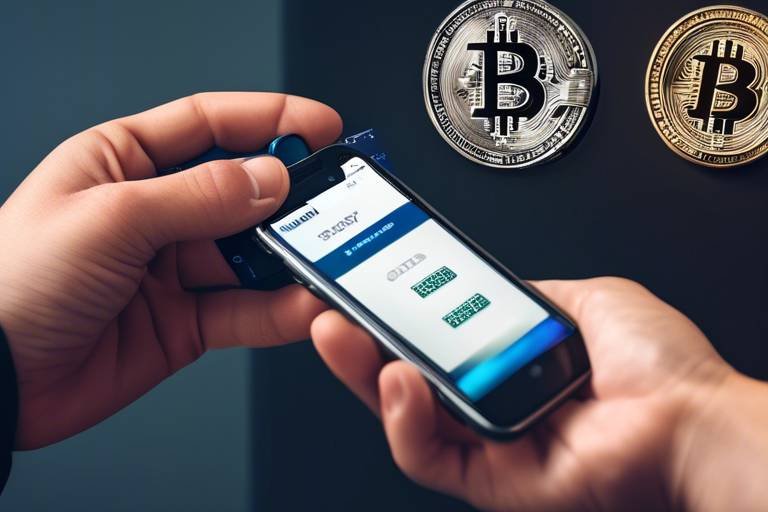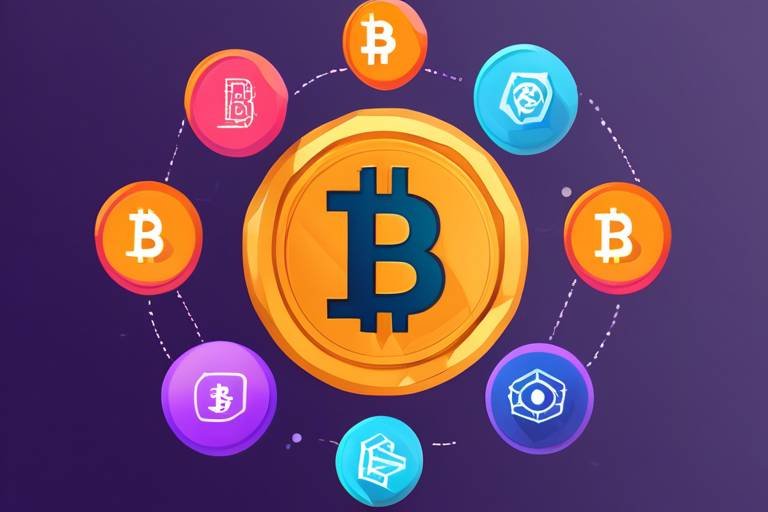The Future of Payments - Crypto vs. Traditional Currency
The world of finance is undergoing a seismic shift, and at the heart of this revolution lies a fascinating clash between cryptocurrency and traditional currency. As we navigate through the complexities of modern payment systems, it’s essential to understand how these two forms of currency interact, compete, and even complement each other. With the rapid rise of digital currencies like Bitcoin and Ethereum, many are left wondering: Is cryptocurrency the future of payments, or will traditional currencies continue to reign supreme? This article will explore this evolving landscape, shedding light on the implications for consumers, businesses, and the global economy.
To grasp the future of payments, we first need to understand what cryptocurrency is all about. At its core, cryptocurrency is a form of digital or virtual currency that employs cryptography for security. Unlike traditional currencies, which are issued and regulated by governments, cryptocurrencies operate on a decentralized network using blockchain technology. This means that transactions occur directly between users without the need for intermediaries like banks. The appeal of cryptocurrency lies in its potential for greater privacy, lower transaction fees, and the ability to bypass traditional financial systems.
Despite the buzz surrounding cryptocurrencies, traditional currency remains deeply ingrained in our financial systems. For centuries, cash has been the backbone of commerce, and even in our increasingly digital world, it continues to hold significant value. Traditional currencies are backed by governments and central banks, providing a sense of stability and trust that many consumers still rely on. As digital currencies gain traction, traditional currencies are adapting by incorporating technology, such as mobile payment systems and contactless transactions, to meet contemporary consumer needs.
So, what makes cryptocurrency so attractive? Here are some of the key advantages:
- Lower Transaction Fees: Cryptocurrency transactions often come with significantly lower fees compared to traditional banking methods. This is especially beneficial for businesses that deal with international payments.
- Increased Security: With the use of cryptographic techniques, cryptocurrency transactions are highly secure. This reduces the risk of fraud and hacking, which are prevalent in centralized banking systems.
- Financial Inclusion: Cryptocurrencies can offer financial services to unbanked populations, providing a more inclusive approach to global finance.
One of the most compelling features of cryptocurrency is its decentralized nature. Unlike traditional banking systems that rely on a central authority, cryptocurrencies operate on a network of computers worldwide. This decentralization enhances security, as there is no single point of failure. In fact, the blockchain technology that underpins cryptocurrencies creates a transparent and immutable ledger of all transactions, making it incredibly difficult for fraudsters to manipulate the system.
Imagine a world where anyone, regardless of their location or financial status, can access financial services. Cryptocurrency has the potential to make this dream a reality. By leveraging the internet, cryptocurrencies can reach unbanked populations in remote areas, providing them with the tools to participate in the global economy. This could lead to a more equitable financial landscape, where everyone has the opportunity to thrive.
However, it's not all sunshine and rainbows. The road to widespread cryptocurrency adoption is fraught with challenges. Regulatory issues are a significant hurdle, as governments around the world grapple with how to classify and regulate these digital assets. Additionally, the inherent volatility of cryptocurrencies can deter potential users, as prices can fluctuate dramatically within short periods. Lastly, technological barriers, such as the need for internet access and understanding of digital wallets, may hinder widespread use.
As we look to the future, it's clear that technology will play a pivotal role in shaping payment systems. From blockchain technology to digital wallets, advancements in technology are driving innovation in both cryptocurrency and traditional finance. These technologies are not just buzzwords; they're the backbone of a new financial ecosystem.
Blockchain technology is revolutionizing how transactions are processed. By providing a transparent and secure way to record transactions, blockchain enhances trust between parties. This is particularly important in an era where digital fraud is rampant. With blockchain, every transaction is recorded in a public ledger, making it nearly impossible to alter or delete once confirmed.
In recent years, digital wallets and payment applications have surged in popularity. These tools facilitate seamless transactions, whether you're using traditional currency or cryptocurrency. They allow users to store multiple currencies, track spending, and make payments with just a few taps on their smartphones. As technology continues to evolve, we can expect even more innovative solutions that bridge the gap between crypto and traditional finance.
As we gaze into the crystal ball, several trends are emerging that will shape the future of payment systems. The integration of cryptocurrency into everyday transactions is likely to grow, driven by consumer demand for more flexible payment options. Additionally, the rise of decentralized finance (DeFi) could challenge traditional banking models, offering consumers alternatives that are faster, cheaper, and more secure. As technology continues to advance, we may witness a hybrid model where cryptocurrency and traditional currency coexist, each serving its unique purpose in the financial ecosystem.
Q: What is cryptocurrency?
A: Cryptocurrency is a digital or virtual currency that uses cryptography for security and operates on a decentralized network.
Q: How does cryptocurrency differ from traditional currency?
A: Unlike traditional currency, which is regulated by governments, cryptocurrency operates independently on a blockchain network.
Q: What are the benefits of using cryptocurrency?
A: Benefits include lower transaction fees, increased security, and greater accessibility for unbanked populations.
Q: What challenges does cryptocurrency face?
A: Challenges include regulatory issues, price volatility, and technological barriers to adoption.

Understanding Cryptocurrency
Cryptocurrency is a term that has been buzzing around the financial world like a swarm of bees, and for good reason! It's a revolutionary concept that has the potential to change how we think about money. At its core, cryptocurrency is a digital or virtual form of currency that uses cryptography for security. This means that it’s designed to be secure and, in many cases, anonymous. But how does it work, and why is it gaining so much traction?
One of the most fascinating aspects of cryptocurrency is its decentralized nature. Unlike traditional currencies that are regulated by governments and financial institutions, cryptocurrencies operate on a technology called blockchain. This is a distributed ledger that records all transactions across a network of computers. Imagine a giant notebook that everyone can see, but no one can erase or alter. This transparency not only builds trust but also enhances security, as there’s no single point of failure that hackers can exploit.
The appeal of cryptocurrency extends beyond just its technical marvels. For many, it represents a freedom from traditional banking systems. No more waiting in long lines at the bank or worrying about hidden fees! With cryptocurrencies, you can send money across the globe in a matter of minutes, often with lower transaction costs compared to traditional methods. This is particularly attractive to those who are unbanked or underbanked, as it opens up new avenues for financial participation.
However, it’s essential to understand that the world of cryptocurrency is not without its complexities. The volatility of cryptocurrencies often leaves people scratching their heads. Prices can soar to unimaginable heights one day and plummet the next, making it a risky investment for some. Moreover, while the decentralized nature of cryptocurrency provides numerous benefits, it also raises questions about regulation and consumer protection. As the landscape evolves, it will be crucial for both users and regulators to navigate these waters carefully.
In conclusion, understanding cryptocurrency is like peering into a new dimension of finance. It offers exciting possibilities, but it also requires a solid grasp of its mechanisms and implications. As we move forward, the dialogue around cryptocurrency will likely intensify, attracting more individuals and businesses to this digital frontier. Are you ready to take the plunge into the world of cryptocurrency? The future of payments may just depend on it!

The Rise of Traditional Currency
Despite the buzz surrounding cryptocurrencies, traditional currency remains a cornerstone of the global economy. It's fascinating to think about how far we've come from barter systems to the complex financial networks we have today. Traditional currency, backed by governments and central banks, provides a sense of stability that many people find reassuring. After all, who doesn't appreciate the familiar feel of cash in their pocket or the ease of swiping a card at a checkout?
Historically, traditional currencies have adapted to the needs of societies. From the gold standard to fiat money, these currencies have evolved alongside technological advancements and societal changes. For instance, the introduction of credit cards in the 20th century revolutionized how people made purchases, allowing for instant credit and convenience. Today, we live in an era where contactless payments and mobile banking are becoming the norm, showcasing the resilience and adaptability of traditional currency.
As we navigate through this digital age, traditional currency continues to play a vital role in our daily lives. It’s not just about cash; it’s about trust and reliability. People often feel more secure using a currency that has a long-standing history and is regulated by a central authority. This trust is crucial, especially when it comes to larger transactions, such as buying a house or investing in a business.
Moreover, traditional currency has a well-established infrastructure that supports its use. Banks, ATMs, and payment processors have been fine-tuned over decades to ensure smooth transactions. In contrast, the infrastructure for cryptocurrencies is still developing, which can lead to confusion and hesitation among consumers. While digital wallets and payment apps are gaining traction, many people still prefer the familiarity of their bank’s services.
In a world where digital currencies are gaining popularity, traditional currency is not just surviving; it’s thriving. Its ability to adapt to new technology and consumer behavior ensures that it remains relevant. For example, many financial institutions are now incorporating blockchain technology to enhance security and efficiency in traditional transactions. This fusion of old and new could pave the way for a more integrated financial landscape.
Ultimately, the rise of traditional currency is a testament to its enduring value. While cryptocurrencies offer exciting possibilities, the stability and trust associated with traditional money are hard to overlook. As we explore the future of payments, it's clear that traditional currency will continue to coexist with digital alternatives, each offering unique benefits to consumers and businesses alike.
- What is traditional currency? Traditional currency refers to money that is issued by a government and is widely accepted as a medium of exchange, such as cash and coins.
- How does traditional currency adapt to modern needs? Traditional currency adapts by integrating new technologies, such as digital banking and contactless payments, while maintaining its regulatory framework.
- Can traditional currency and cryptocurrency coexist? Yes, both can coexist, offering consumers different options based on their preferences and needs.
- What are the benefits of using traditional currency? Benefits include stability, widespread acceptance, and a well-established infrastructure for transactions.

Advantages of Cryptocurrency
Cryptocurrency has emerged as a revolutionary force in the financial landscape, offering a plethora of benefits that traditional currencies struggle to match. One of the most compelling advantages is the lower transaction fees. Unlike conventional banking systems that often impose hefty fees for international transfers or currency exchanges, cryptocurrencies can facilitate these transactions at a fraction of the cost. Imagine sending money across the globe without worrying about exorbitant fees eating into your funds—this is the promise of digital currencies.
Moreover, the increased security offered by cryptocurrencies cannot be overlooked. With the rise of cyber threats, many consumers are rightfully concerned about the safety of their financial transactions. Cryptocurrencies utilize advanced cryptographic techniques that secure transactions and protect user identities. This decentralization means that there is no single point of failure, making it significantly harder for hackers to compromise the system. In fact, the blockchain technology that underpins cryptocurrencies ensures that every transaction is recorded on a public ledger, providing transparency and traceability.
Another significant advantage is the potential for financial inclusion. Globally, there are billions of people who remain unbanked or underbanked, lacking access to traditional banking services. Cryptocurrencies can bridge this gap by providing a means of financial transaction that does not rely on conventional banking infrastructure. With just a smartphone and internet access, individuals can engage in the global economy, send and receive funds, and even invest in assets. This opens up a world of opportunities for those who have previously been excluded from the financial system.
In addition, cryptocurrencies offer a level of global accessibility that is unmatched by traditional currencies. With a decentralized network, users can transact freely across borders without the need for currency conversion or dealing with fluctuating exchange rates. This is particularly beneficial for expatriates sending remittances back home, as they can send funds quickly and efficiently, often with minimal fees. The convenience of accessing one’s funds from anywhere in the world is a game-changer for many.
However, it’s essential to acknowledge that while the advantages are compelling, they come with their own set of challenges. The volatility of cryptocurrencies can deter some users, as prices can fluctuate wildly in a short period. Yet, for those who can navigate this landscape, the benefits far outweigh the risks. As the world becomes more interconnected, the advantages of cryptocurrencies are likely to play a pivotal role in shaping the future of payments.
- What are the main advantages of using cryptocurrency?
The main advantages include lower transaction fees, increased security, financial inclusion for unbanked populations, and global accessibility.
- How does cryptocurrency ensure security?
Cryptocurrencies use cryptographic techniques and a decentralized network to secure transactions, making it difficult for hackers to compromise the system.
- Can cryptocurrencies help the unbanked population?
Yes, cryptocurrencies can provide financial services to those without access to traditional banking, allowing them to participate in the global economy.

Decentralization and Security
When we talk about decentralization in the realm of cryptocurrency, we're diving into a revolutionary concept that fundamentally changes how we think about money and transactions. Unlike traditional banking systems that rely on a central authority—like a bank or a government—cryptocurrency operates on a decentralized network of computers, known as nodes. This means that no single entity has control over the entire network, which significantly enhances security and reduces the risk of fraud.
Imagine a traditional bank where all your money and transaction records are held in one place. If that bank were to be hacked or go bankrupt, your funds could be at risk. In contrast, the decentralized nature of cryptocurrency spreads the data across multiple locations. Each transaction is recorded on a public ledger called the blockchain, which is accessible to everyone but controlled by no one. This transparency ensures that once a transaction is made, it cannot be altered or deleted, making it incredibly difficult for hackers to manipulate the system.
Furthermore, the security protocols employed by cryptocurrencies, such as cryptographic algorithms, add an additional layer of protection. These algorithms encrypt transaction data, making it nearly impossible for unauthorized parties to access sensitive information. To illustrate this point, consider the following:
| Aspect | Traditional Banking | Cryptocurrency |
|---|---|---|
| Control | Centralized | Decentralized |
| Transaction Records | Stored in one place | Distributed across the network |
| Risk of Fraud | Higher | Lower |
| Transparency | Limited | High |
This table clearly highlights the differences in security and control between traditional banking and cryptocurrency. The decentralized model not only protects individual users but also enhances the integrity of the entire financial system. When transactions are verified by multiple nodes, it creates a consensus that ensures accuracy and reliability.
Moreover, the peer-to-peer nature of cryptocurrency transactions eliminates the need for intermediaries, such as banks or payment processors. This not only speeds up the transaction process but also reduces costs, as users are not burdened with hefty fees associated with traditional financial services. However, it’s essential to remember that while decentralization offers numerous benefits, it also places the onus of security on the individual. Users must take precautions to safeguard their digital wallets and private keys, as there is no central authority to recover lost funds.
In summary, the decentralization of cryptocurrency significantly enhances security by distributing control, utilizing advanced cryptographic techniques, and fostering transparency. As we move forward in the evolving landscape of finance, understanding these principles will be crucial for consumers and businesses alike.
- What is decentralization in cryptocurrency? Decentralization refers to the distribution of control and data across a network, eliminating the need for a central authority.
- How does decentralization enhance security? By spreading data across multiple nodes, it makes it difficult for hackers to manipulate the system, ensuring transaction integrity.
- What are cryptographic algorithms? These are mathematical algorithms used to encrypt data, providing an additional layer of security for cryptocurrency transactions.
- Is cryptocurrency completely safe? While decentralization enhances security, users must still take precautions to protect their digital wallets and private keys.

Global Accessibility
In today's interconnected world, is more than just a buzzword; it’s a necessity. Cryptocurrency has emerged as a beacon of hope for millions of people who have been historically marginalized from traditional financial systems. Imagine living in a rural area where banks are miles away, or in a country where the local currency is unstable—these are the realities for many individuals. Cryptocurrency offers a solution by allowing anyone with an internet connection to participate in the global economy.
One of the most compelling aspects of cryptocurrency is its ability to transcend geographical barriers. Unlike traditional banking systems, which often impose strict regulations and require extensive documentation, cryptocurrencies can be accessed by anyone, anywhere. This democratization of finance means that even those without a bank account can engage in transactions, send money across borders, or invest in digital assets. For instance, a farmer in a remote village can receive payments directly from buyers around the world without needing to navigate the complexities of international banking.
Furthermore, the low transaction fees associated with cryptocurrency are particularly advantageous for people in developing countries. Traditional remittance services can charge exorbitant fees, often taking a significant cut of the money sent home. In contrast, cryptocurrencies typically involve lower fees, allowing more of the funds to reach the intended recipient. This is especially crucial for families relying on remittances from abroad to support their livelihoods.
Consider the following table that illustrates the differences in transaction costs between traditional remittance services and cryptocurrency:
| Service Type | Average Transaction Fee | Time to Complete |
|---|---|---|
| Traditional Remittance | 7-10% | 1-5 days |
| Cryptocurrency Transfer | 0.5-2% | 10-30 minutes |
Moreover, the rise of mobile technology has further enhanced accessibility. With smartphones becoming ubiquitous, people can now manage their cryptocurrency wallets and conduct transactions directly from their mobile devices. This is a game-changer for those in regions where traditional banking infrastructure is lacking. The ability to send and receive funds instantly and securely can empower individuals, enabling them to engage in commerce, invest in education, or even start their own businesses.
However, it’s essential to acknowledge that while cryptocurrency opens doors, it also requires a certain level of digital literacy. As with any technology, there’s a learning curve, and the challenge lies in ensuring that everyone can navigate this new financial landscape. Educational initiatives and community programs are crucial in helping people understand how to use cryptocurrencies safely and effectively.
In conclusion, the global accessibility offered by cryptocurrency represents a significant shift in the financial paradigm. It allows individuals from all walks of life to participate in the economy, fostering a sense of inclusion and empowerment. As we move forward, it is vital to harness this potential while addressing the challenges that come with it, ensuring that the benefits of cryptocurrency are available to everyone, regardless of their background.
- What is cryptocurrency? Cryptocurrency is a digital or virtual form of currency that uses cryptography for security and operates on a decentralized network called blockchain.
- How can cryptocurrency improve global accessibility? Cryptocurrency allows individuals without access to traditional banking systems to participate in the economy, enabling transactions and financial services through internet connectivity.
- What are the risks associated with using cryptocurrency? Risks include price volatility, potential regulatory changes, and the need for digital literacy to navigate the technology safely.
- Are there any fees for using cryptocurrency? While cryptocurrency transactions generally have lower fees compared to traditional banking systems, fees can vary depending on the network congestion and the specific cryptocurrency used.

Challenges of Cryptocurrency
While cryptocurrency has undoubtedly captured the imagination of many and presents exciting possibilities, it also faces a myriad of challenges that could impede its widespread adoption. One of the most significant hurdles is regulatory uncertainty. Governments around the world are still grappling with how to classify and regulate cryptocurrencies. Some countries have embraced them, while others have imposed strict bans or regulations that stifle innovation. This lack of a clear regulatory framework creates confusion for consumers and businesses alike, making it difficult to navigate the crypto landscape.
Another major challenge is volatility. Cryptocurrencies are notorious for their price fluctuations. Imagine waking up one morning to find that the value of your Bitcoin has plummeted by 30% overnight! Such volatility can deter both consumers and merchants from fully embracing digital currencies. After all, how can you trust a payment method that could lose its value in a matter of hours? This unpredictability makes it hard for businesses to price goods and services, leading to a reluctance to accept cryptocurrencies as a form of payment.
Moreover, there are technological barriers that can hinder the adoption of cryptocurrency. While blockchain technology is revolutionary, it’s also complex. Many people still lack a basic understanding of how cryptocurrencies work, which can lead to skepticism. For instance, the process of setting up a digital wallet or conducting a transaction can be daunting for those unfamiliar with technology. Additionally, issues such as transaction speed and scalability can further complicate matters. As more users flock to the network, the system can become congested, leading to slow transaction times and higher fees.
Security is another critical concern. Although cryptocurrencies are designed to be secure, they are not immune to hacking and fraud. High-profile thefts and breaches have made headlines, raising questions about the safety of digital assets. In fact, a recent report indicated that over $1.9 billion worth of cryptocurrency was stolen in 2020 alone. This reality can make potential investors wary, as they weigh the risks of losing their hard-earned money against the potential rewards of investing in digital currencies.
Lastly, there is the issue of public perception. Many people still associate cryptocurrency with illicit activities, such as money laundering and drug trafficking. This stigma can deter mainstream adoption and acceptance, as businesses and consumers may hesitate to engage with a payment method that carries such a negative connotation. Overcoming this perception will require education and transparency, both of which are essential for fostering trust in cryptocurrency.
In summary, while the allure of cryptocurrency is undeniable, these challenges must be addressed for it to reach its full potential. Regulatory clarity, reduced volatility, improved technology, enhanced security measures, and a shift in public perception are all vital for paving the way toward a future where cryptocurrency can coexist alongside traditional currency.
- What are the main challenges facing cryptocurrency? The primary challenges include regulatory uncertainty, volatility, technological barriers, security concerns, and public perception.
- Why is regulatory uncertainty a problem for cryptocurrency? Without clear regulations, businesses and consumers face confusion and risk, which can hinder adoption.
- How does volatility affect cryptocurrency use? Price fluctuations can make it difficult for consumers and businesses to trust cryptocurrencies as a stable form of payment.
- Are cryptocurrencies secure? While designed to be secure, cryptocurrencies can still be vulnerable to hacks and fraud.
- How can public perception of cryptocurrency change? Education and transparency are key to overcoming negative associations with digital currencies.

The Role of Technology in Payments
In today's fast-paced world, technology is the backbone of our payment systems, transforming how we exchange value and conduct transactions. Imagine a world where cash is obsolete, and every transaction is seamless and instantaneous. This is not just a dream; it's becoming a reality thanks to the rapid advancements in technology that are reshaping the payment landscape. From blockchain to digital wallets, these innovations are not only enhancing security but also making payments more accessible and efficient for everyone.
At the heart of this transformation lies blockchain technology, which is revolutionizing the way we think about transactions. Unlike traditional systems that rely on centralized authorities, blockchain operates on a decentralized network. This means that every transaction is recorded on a public ledger, enhancing transparency and reducing the risk of fraud. In fact, a study by the World Economic Forum predicts that by 2025, 10% of global GDP could be stored on blockchain technology, showcasing its potential to redefine financial transactions.
Moreover, the integration of digital wallets and payment apps is another significant trend in the payment ecosystem. These platforms allow users to store their payment information securely, making transactions as easy as a tap on their smartphone. With the rise of contactless payments, consumers can now make purchases without ever needing to handle cash or cards. This convenience is not only appealing to tech-savvy millennials but is also gaining traction among older generations who appreciate the ease of use. According to a recent survey, over 60% of consumers prefer using digital wallets for their transactions due to their speed and security.
However, the role of technology in payments goes beyond just convenience. It also plays a crucial part in addressing financial inclusion. For instance, many people in developing countries lack access to traditional banking services. With the advent of mobile payment solutions, individuals can now participate in the global economy without needing a bank account. This shift is empowering millions, allowing them to send and receive money, pay bills, and even save for the future. In fact, the Global Financial Inclusion Index highlights that mobile money services have significantly increased financial access in regions like Sub-Saharan Africa.
As we look to the future, it's clear that technology will continue to drive innovation in payment systems. With the emergence of technologies like artificial intelligence and machine learning, we can expect even more personalized payment experiences. These technologies can analyze consumer behavior, predict spending habits, and offer tailored financial solutions, making transactions smoother and more efficient than ever before.
In summary, the role of technology in payments is multifaceted and dynamic. It not only enhances the speed and security of transactions but also fosters inclusivity and convenience for consumers worldwide. As we embrace these changes, it's essential to stay informed about the latest advancements and trends that will shape the future of payments.
- What is blockchain technology?
Blockchain is a decentralized digital ledger that records transactions across many computers in a way that the registered transactions cannot be altered retroactively, ensuring security and transparency. - How do digital wallets work?
Digital wallets store payment information securely and allow users to make transactions via smartphones or computers, often using technologies like NFC (Near Field Communication) for contactless payments. - Are cryptocurrencies safe to use?
While cryptocurrencies offer enhanced security through encryption and decentralization, they are not entirely risk-free. Users should be aware of potential volatility and regulatory issues. - What are the benefits of using mobile payments?
Mobile payments provide convenience, speed, and often lower transaction fees compared to traditional payment methods, making them increasingly popular among consumers.

Blockchain Technology
Blockchain technology is often hailed as the backbone of cryptocurrency, but its implications stretch far beyond just digital currencies. At its core, a blockchain is a decentralized ledger that records transactions across many computers in such a way that the registered transactions cannot be altered retroactively. This means that once a transaction is added to the blockchain, it becomes a permanent part of the record, ensuring transparency and trust among users. Imagine a public library where every book is a transaction, and once a book is placed on the shelf, it cannot be removed or changed without everyone knowing. This analogy illustrates how blockchain fosters a secure environment for transactions.
One of the most significant advantages of blockchain technology is its ability to enhance transparency. In traditional banking systems, transactions are often opaque, with users having little insight into what happens behind the scenes. However, with blockchain, every participant in the network has access to the same information, which can significantly reduce fraud and corruption. This level of transparency is crucial not only for cryptocurrencies but also for various industries, including supply chain management, healthcare, and even voting systems.
Moreover, blockchain technology is inherently secure. The decentralized nature of the system means that there is no single point of failure. In a traditional centralized system, if a hacker gains access to one server, they can potentially manipulate or steal vast amounts of data. In contrast, with blockchain, the data is distributed across numerous nodes, making it exceedingly difficult for any malicious actor to alter the information without the consensus of the majority. This security feature is particularly appealing for businesses and consumers alike, as it builds trust in digital transactions.
Another fascinating aspect of blockchain is its potential to streamline processes and reduce costs. By eliminating intermediaries such as banks and payment processors, blockchain can facilitate faster transactions at a fraction of the cost. For instance, international money transfers can take several days and incur hefty fees, but with blockchain, these transactions can occur almost instantaneously and at a lower cost. This efficiency can have profound implications for global commerce and finance, making it easier for businesses to operate across borders.
To illustrate the impact of blockchain technology, consider the following table that outlines some of its key features and benefits:
| Feature | Benefit |
|---|---|
| Decentralization | Reduces the risk of single points of failure and fraud. |
| Transparency | Allows all parties to view the same data, fostering trust. |
| Security | Utilizes cryptography to protect data and transactions. |
| Cost Efficiency | Reduces transaction costs by eliminating intermediaries. |
| Speed | Facilitates faster transactions, especially in cross-border payments. |
In conclusion, blockchain technology is not just a passing trend; it represents a fundamental shift in how we think about transactions and data integrity. As more industries begin to recognize its potential, we can expect to see a growing integration of blockchain solutions into everyday financial operations. Whether you're a consumer, a business owner, or a tech enthusiast, understanding the implications of blockchain technology is essential as we move towards a more digital and decentralized future.
- What is blockchain technology? Blockchain is a decentralized digital ledger that records transactions across multiple computers, ensuring that the recorded transactions cannot be altered retroactively.
- How does blockchain enhance security? By distributing data across a network of nodes, blockchain eliminates single points of failure, making it difficult for hackers to manipulate information.
- Can blockchain be used outside of cryptocurrency? Yes, blockchain technology has applications in various fields including supply chain management, healthcare, and voting systems.
- What are the cost benefits of using blockchain? Blockchain reduces costs by eliminating intermediaries, allowing for faster and cheaper transactions.

Digital Wallets and Payment Apps
In today’s fast-paced digital world, digital wallets and payment apps have emerged as game-changers in how we handle our finances. Gone are the days when you had to carry around cash or even physical credit cards. Now, with just a few taps on your smartphone, you can make purchases, transfer money, and manage your finances seamlessly. But what exactly are these digital wallets, and why are they gaining so much traction?
Digital wallets, often referred to as e-wallets, allow users to store their payment information securely online. They can hold a variety of payment methods, including credit cards, debit cards, and even cryptocurrencies. Imagine having all your financial tools in one place, accessible at your fingertips. This convenience is a significant reason why they are becoming increasingly popular among consumers and businesses alike.
Payment apps, on the other hand, are platforms that facilitate transactions, whether it’s sending money to a friend or paying for groceries. Think of them as the digital equivalent of your wallet, but with the added benefits of speed and enhanced security. Popular apps like PayPal, Venmo, and Cash App have revolutionized peer-to-peer payments, making it easier than ever to split bills or send money across the globe without the hassle of traditional banking methods.
One of the most appealing aspects of digital wallets and payment apps is their user-friendly interfaces. Most of these applications are designed to be intuitive, allowing even the least tech-savvy individuals to navigate them with ease. With features such as QR code scanning, one-click payments, and instant notifications, users can enjoy a hassle-free payment experience. Additionally, many of these apps offer loyalty programs and rewards, giving users an extra incentive to choose digital payments over cash.
However, it's essential to address some concerns surrounding digital wallets and payment apps. Security is a top priority for users, and while these platforms typically employ advanced encryption and security measures, there is always a risk of cyber threats. It’s crucial for users to stay vigilant and take necessary precautions, such as enabling two-factor authentication and keeping their devices updated.
Moreover, the integration of blockchain technology into digital wallets is a fascinating development. Blockchain enhances security and transparency, making transactions more reliable. As cryptocurrencies become more mainstream, digital wallets that support these currencies are likely to see increased adoption. This evolution could potentially reshape the landscape of not just how we pay but also how we perceive value itself.
In summary, digital wallets and payment apps are not just a trend; they represent a significant shift in the way we interact with money. With their convenience, security features, and potential for innovation, they are paving the way for a more efficient financial future. As we continue to embrace technology, it’s exciting to think about how these tools will evolve and what new possibilities they will bring to our everyday transactions.
- What is a digital wallet? A digital wallet is an electronic application that allows users to store payment information and make transactions online or via mobile devices.
- Are digital wallets safe to use? Yes, most digital wallets employ advanced security measures like encryption and two-factor authentication to protect users' information.
- Can I use digital wallets for cryptocurrency transactions? Yes, many digital wallets now support cryptocurrencies, allowing users to buy, sell, and store digital assets securely.
- What are some popular payment apps? Some popular payment apps include PayPal, Venmo, Cash App, and Google Pay, each offering unique features and benefits.

Future Trends in Payment Systems
The landscape of payment systems is evolving at a breakneck speed, driven by technological advancements and shifting consumer preferences. As we look to the future, we can expect to see a blend of cryptocurrency and traditional currency systems coexisting, each adapting to meet the demands of a rapidly changing world. One of the most exciting trends is the integration of artificial intelligence (AI) into payment systems. AI can analyze vast amounts of data to predict consumer behavior, streamline transactions, and enhance security measures. Imagine a world where your payment system knows your preferences so well that it can offer personalized discounts or alerts about potential fraud before you even notice something amiss.
Moreover, the rise of contactless payments is reshaping how we think about transactions. With just a tap of your card or smartphone, payments can be made in seconds. This convenience is not just limited to retail; it’s spilling over into online shopping and even peer-to-peer transactions. As more people embrace the convenience of contactless payments, we can expect to see a decline in cash usage, pushing us closer to a cashless society. But what does this mean for the future? It suggests a world where digital wallets become the norm, and physical currency is relegated to the history books.
Another significant trend is the emergence of decentralized finance (DeFi). This movement aims to recreate traditional financial systems—like lending, borrowing, and trading—using blockchain technology. DeFi platforms operate without intermediaries, allowing users to transact directly with one another. The implications are enormous; it could democratize access to financial services, especially for those in developing regions where traditional banking is limited. However, with great power comes great responsibility. Users must navigate the complexities and risks associated with DeFi, including potential hacks and regulatory scrutiny.
Furthermore, the concept of central bank digital currencies (CBDCs) is gaining traction worldwide. Governments are exploring the idea of issuing their own digital currencies, which could combine the best aspects of cryptocurrency with the stability of traditional money. CBDCs could offer a more secure and efficient way to conduct transactions, while also providing central banks with greater control over monetary policy. As countries like China and Sweden pilot their digital currencies, it will be fascinating to see how this trend unfolds and what it means for the future of global finance.
In addition to these trends, we cannot overlook the growing emphasis on security and privacy. As digital transactions become more prevalent, consumers are becoming increasingly concerned about their data being compromised. Payment systems will need to prioritize robust security measures, such as biometric authentication and advanced encryption technologies, to build trust with users. The challenge will be to balance convenience and security, ensuring that transactions remain seamless while safeguarding sensitive information.
To sum it all up, the future of payment systems is not just about choosing between cryptocurrency and traditional currency; it’s about finding a harmonious balance that leverages the strengths of both. As technology continues to evolve, so too will the ways in which we transact. Whether it’s through AI-driven insights, contactless payments, DeFi, CBDCs, or enhanced security measures, the payment landscape is on the brink of a revolution that promises to make our financial interactions more efficient, secure, and inclusive.
- What is the main difference between cryptocurrency and traditional currency?
Cryptocurrency is decentralized and operates on blockchain technology, while traditional currency is regulated by governments and central banks. - How does AI impact payment systems?
AI can enhance payment systems by predicting consumer behavior, streamlining transactions, and improving security measures. - What are CBDCs?
Central Bank Digital Currencies (CBDCs) are digital forms of a country's fiat currency, issued and regulated by the central bank. - Are contactless payments secure?
Yes, contactless payments use encryption and tokenization to protect transaction data, making them a secure option for consumers. - What challenges does cryptocurrency face?
Cryptocurrency faces challenges such as regulatory issues, volatility, and technological barriers that may hinder widespread adoption.
Frequently Asked Questions
- What is cryptocurrency?
Cryptocurrency is a digital or virtual form of currency that uses cryptography for security. Unlike traditional currencies issued by governments, cryptocurrencies operate on decentralized networks based on blockchain technology, allowing for secure and transparent transactions.
- How does cryptocurrency work?
Cryptocurrency works through a technology called blockchain, which is a distributed ledger that records all transactions across a network of computers. Each transaction is verified by network nodes through cryptography and is added to a block, which is then linked to a previous block, forming a chain.
- What are the advantages of using cryptocurrency?
Some of the key advantages of cryptocurrency include lower transaction fees, enhanced security through decentralization, and the potential for financial inclusion for unbanked populations. It also allows for faster cross-border transactions compared to traditional banking methods.
- What challenges does cryptocurrency face?
Cryptocurrency faces several challenges, including regulatory uncertainty, price volatility, and technological barriers. These issues can hinder widespread adoption and create skepticism among potential users.
- How do digital wallets work?
Digital wallets are applications that allow users to store, send, and receive cryptocurrencies securely. They can be software-based (on a computer or smartphone) or hardware-based (physical devices) and provide users with a unique address to facilitate transactions.
- Will traditional currency disappear with the rise of cryptocurrency?
While cryptocurrency is gaining popularity, it is unlikely that traditional currency will disappear entirely. Instead, both forms of currency may coexist, with each serving different purposes in the financial ecosystem.
- How is blockchain technology changing the payment landscape?
Blockchain technology enhances the payment landscape by providing greater transparency, security, and efficiency in transactions. It reduces the need for intermediaries, lowers costs, and speeds up the settlement process, making it an attractive option for businesses and consumers alike.
- What future trends can we expect in payment systems?
Future trends in payment systems may include increased adoption of cryptocurrency, the integration of advanced technologies like AI and machine learning, and the rise of contactless payment methods. Consumers will likely demand more seamless and secure transaction experiences, pushing for innovations in both traditional and digital payment systems.



















